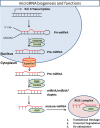Non-Coding RNAs in Psychiatric Disorders and Suicidal Behavior
- PMID: 33101077
- PMCID: PMC7522197
- DOI: 10.3389/fpsyt.2020.543893
Non-Coding RNAs in Psychiatric Disorders and Suicidal Behavior
Abstract
It is well known that only a small proportion of the human genome code for proteins; the rest belong to the family of RNAs that do not code for protein and are known as non-coding RNAs (ncRNAs). ncRNAs are further divided into two subclasses based on size: 1) long non-coding RNAs (lncRNAs; >200 nucleotides) and 2) small RNAs (<200 nucleotides). Small RNAs contain various family members that include microRNAs (miRNAs), small interfering RNAs (siRNAs), piwi-interacting RNAs (piRNAs), small nucleolar RNAs (snoRNAs), and small nuclear RNAs (snRNAs). The roles of ncRNAs, especially lncRNAs and miRNAs, are well documented in brain development, homeostasis, stress responses, and neural plasticity. It has also been reported that ncRNAs can influence the development of psychiatric disorders including schizophrenia, major depressive disorder, and bipolar disorder. More recently, their roles are being investigated in suicidal behavior. In this article, we have comprehensively reviewed the findings of lncRNA and miRNA expression changes and their functions in various psychiatric disorders including suicidal behavior. We primarily focused on studies that have been done in postmortem human brain. In addition, we have briefly reviewed the role of other small RNAs (e.g. piwiRNA, siRNA, snRNA, and snoRNAs) and their expression changes in psychiatric illnesses.
Keywords: bipolar disorder; long non-coding RNAs; major depressive disorder; microRNAs; schizophrenia.
Copyright © 2020 Yoshino and Dwivedi.
Figures



Similar articles
-
Non-Coding RNAs as Mediators of Epigenetic Changes in Malignancies.Cancers (Basel). 2020 Dec 5;12(12):3657. doi: 10.3390/cancers12123657. Cancers (Basel). 2020. PMID: 33291485 Free PMC article. Review.
-
Non-Coding RNAs and Endometrial Cancer.Genes (Basel). 2018 Mar 29;9(4):187. doi: 10.3390/genes9040187. Genes (Basel). 2018. PMID: 29596364 Free PMC article. Review.
-
Emerging Roles and Potential Applications of Non-Coding RNAs in Glioblastoma.Int J Mol Sci. 2020 Apr 9;21(7):2611. doi: 10.3390/ijms21072611. Int J Mol Sci. 2020. PMID: 32283739 Free PMC article. Review.
-
Promoter-based identification of novel non-coding RNAs reveals the presence of dicistronic snoRNA-miRNA genes in Arabidopsis thaliana.BMC Genomics. 2015 Nov 25;16:1009. doi: 10.1186/s12864-015-2221-x. BMC Genomics. 2015. PMID: 26607788 Free PMC article.
-
MicroRNAs and PIWI-interacting RNAs in oncology.Oncol Lett. 2016 Oct;12(4):2289-2292. doi: 10.3892/ol.2016.4996. Epub 2016 Aug 11. Oncol Lett. 2016. PMID: 27698791 Free PMC article.
Cited by
-
miR-218: A Stress-Responsive Epigenetic Modifier.Noncoding RNA. 2022 Jul 21;8(4):55. doi: 10.3390/ncrna8040055. Noncoding RNA. 2022. PMID: 35893238 Free PMC article. Review.
-
Abnormal expression of long non-coding RNAs RMRP, CTC-487M23.5, and DGCR5 in the peripheral blood of patients with Bipolar disorder.Metab Brain Dis. 2024 Feb;39(2):313-320. doi: 10.1007/s11011-023-01316-1. Epub 2023 Nov 14. Metab Brain Dis. 2024. PMID: 37962788
-
Research progress and potential application of microRNA and other non-coding RNAs in forensic medicine.Int J Legal Med. 2024 Mar;138(2):329-350. doi: 10.1007/s00414-023-03091-1. Epub 2023 Sep 28. Int J Legal Med. 2024. PMID: 37770641 Review.
-
Potential of Circulating miRNAs as Molecular Markers in Mood Disorders and Associated Suicidal Behavior.Int J Mol Sci. 2023 Feb 28;24(5):4664. doi: 10.3390/ijms24054664. Int J Mol Sci. 2023. PMID: 36902096 Free PMC article. Review.
-
Investigation of genetic loci shared between bipolar disorder and risk-taking propensity: potential implications for pharmacological interventions.Neuropsychopharmacology. 2021 Aug;46(9):1680-1692. doi: 10.1038/s41386-021-01045-y. Epub 2021 May 25. Neuropsychopharmacology. 2021. PMID: 34035470 Free PMC article.
References
Publication types
LinkOut - more resources
Full Text Sources

